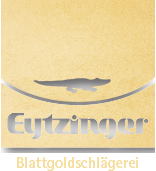Reverse glass gilding – Glass protects the gold leaf against scratching
In terms of the technique, the term reverse glass gilding speaks for itself. Glass or perspex panels protect the gold leaf against potential scratching. The gold leaf is stuck to the glass surface using an adhesive. Depending on the desired appearance of the gold and level of lustre, you can choose from various adhesives, such as gelatine, oil-size, AQUA Waterbased Goldsize or UV adhesive. Reverse glass gilding using different gilding techniques, lustres and gold colours is particularly striking.
Adhesives for reverse glass gilding
Gelatine – is the secret behind brilliant reverse glass gilding. To prepare it, soak 1/4 of a sheet of Dr. Oetker gelatine in one litre of cold distilled water for 30 minutes. A little tip: cut the sheet of gelatine into four pieces with scissors. Then carefully heat the solution over a bain-marie to a maximum of 50°C. Once the gelatine has completely dissolved, stir the warm solution briefly and then pass it through a coffee filter paper. Then add a drop of dishwashing liquid to the filtered solution. The adhesive liquid is now ready for reverse glass gilding.
Clean the pane of glass well and then apply the liquid adhesive to the surface. With a gilder’s tip, apply gold or silver leaf to the wet glass surface. With a brush, coat the not-yet-gilded glass surface with the liquid adhesive again and again to keep it wet as the gold leaf will not stick to a dry pane of glass.
Once the gilding work is complete, place a sheet of dry blotting paper onto the gilded surface and roll over it with a rubber roller, applying slight pressure. The remaining liquid adhesive will be pressed out and absorbed by the blotting paper. Then allow the pane of glass to dry for around 1 – 2 hours. The gilded surface will then shine like a mirror and must now be carefully polished up with clean cotton wool.
The gold leaf surface will generally have several flaws and translucent areas. Therefore, when gilding with gelatine, the process is then repeated, with the surface once again coated with adhesive and gilded.
Oil-size – ideally suited for achieving reverse glass gilding with a silky sheen. The oil-size should be diluted with white spirit at a ratio of 1:1 and applied to the cleaned pane of glass. The surface is then immediately wiped off horizontally with lint-free paper towels. It is important to apply only a wafer-thin and even film of oil-size to the glass surface. The drying time for oil-size is not noticeably affected by diluting.
Wait the required drying time for the oil-size and then gild with loose or transfer gold/silver leaf. Once complete, the surface can then be immediately brushed over with a gilder’s mop and carefully polished with cotton wool*.
AQUA Water Based Goldsize – is suitable as an adhesive for matte reverse glass gilding. It is recommended that the water based goldsize be diluted with around 25 percent distilled water. It can then be applied horizontally and vertically over the glass surface with a foam roller or brush.
The gilding can begin after a drying time of approx. 30 – 60 minutes. Both loose and transfer gold/silver leaves are suitable for this work. The finished surface can then be immediately brushed over and polished with a squirrel hair gilder’s mop. Because the surface of the water based goldsize always remains very soft, it should only be brushed over very briefly and polished with great care.
UV adhesive – allows for new surface finishes when gilding glass. Apply UV adhesive evenly to the cleaned glass surface and then apply loose gold leaf. It is recommended that you work directly from the gold leaf booklet with a gilder’s tip in order to place the gold leaf onto the UV adhesive surface. Once fully gilded, expose the glass surface to a UV light from the glass side. The adhesive hardens and the gold shines with a “crumpled” metallic appearance.
Important tips
*Cotton wool: When polishing gold leaf, only use 100% pure cotton wool. Synthetic fibres scratch the gold leaf on the gilded surface and generally cause a total write-off.
Varnish the reverse side: the majority of reverse glass gilding is varnished on the gold side for purpose of protection. Varnishes with chalk or pigment additive are suitable for this purpose. This reduces the surface tension of the paint and prevents the flat layer of gold from coming away from the glass.


